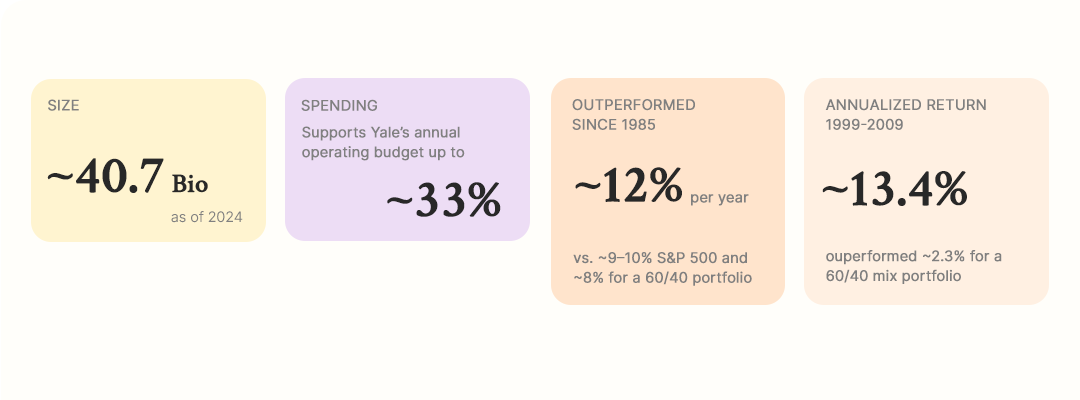Your Money Deserves Ivy League Treatment
Ivy League investing explained: The Yale model and how you can access it with Simpan.
What do Ivy League universities like Yale, Harvard, and Princeton have in common?
When we think of Ivy League universities like Yale, Harvard, and Princeton, prestige in academics often comes to mind. But beyond the classroom, these institutions share another powerful trait: the way they manage their wealth. They rely on a proven strategy known as endowment-style investing.
A quick backstory
This approach was pioneered by market legend David Swensen at Yale. Swensen transformed how institutions think about wealth preservation and growth. Rather than relying solely on public stocks and bonds, Yale shifted to a highly diversified, alternative-heavy portfolio—with allocations to private equity, venture capital, hedge funds, and real assets like real estate and natural resources.
The results were extraordinary:
Yale’s endowment earned ~13% annualized returns over a decade
Consistently outperformed the traditional 60/40 stock-bond portfolio
The success of Yale’s model influenced peers. Today, Harvard, Princeton, MIT, and other leading institutions have adopted this strategy.
Yale at a glance
Why Does It Work?
1. Shift From Traditional 60/40 to Private Markets
In 1985, most universities had ~70–80% of assets in U.S. stocks and bonds. Swensen flipped the model.
This shift provided access to less efficient markets where skilled managers could deliver alpha.
2. Long-Term Horizon = Illiquidity Premium
With no need to liquidate assets quickly, Yale captured the illiquidity premium from long-term investments:
Private equity historically returns ~14–15% annually (Cambridge Associates)
Venture capital, especially in the 1990s–2000s, delivered outsized gains from companies like Google, Facebook, and Airbnb
3. Best-in-Class Managers
Swensen emphasized manager selection as the true alpha driver. Yale secured early access to top-tier private equity and hedge funds such as Silver Lake, Lone Pine Capital, Elliott Management, and Caxton Associates, building relationships that many others couldn’t replicate.
4. Risk Management Through True Diversification
Yale diversified by correlation, not just asset class:
Real assets hedged inflation
Hedge funds delivered absolute returns with low correlation to equities
Overall, this reduced volatility while maintaining strong returns
5. Cultural Discipline
Yale’s advantage wasn’t just strategy—it was discipline:
Commitment to strategies for decades, avoiding short-term performance chasing
Strong governance: The Yale Investments Office has a professional, stable team (Swensen served ~35 years)
What This Means at Simpan
At Simpan, we believe individuals deserve access to the same investment philosophy that powers the world’s most successful institutions. That’s why our portfolio approach is inspired by the endowment model.
What does this mean for you?
For private wealth investors: We bring you Ivy League strategies, access to private markets, and manage your wealth with the same rigor and discipline as an institution.
For retail investors: We bring the Ivy League mindset into your reksa dana—applying the same discipline, diversification, and long-term focus, all accessible through the Simpan App.
Your money deserves Ivy League treatment. We’ll bring that sophistication straight to you through Simpan.



